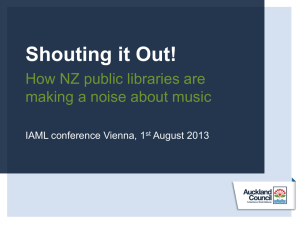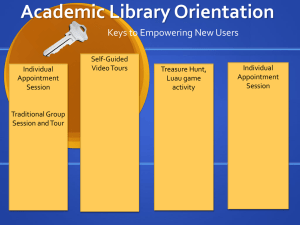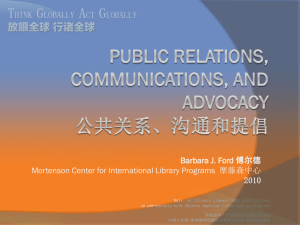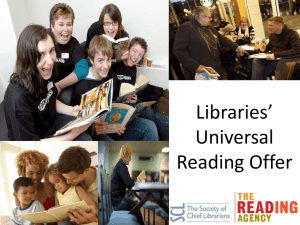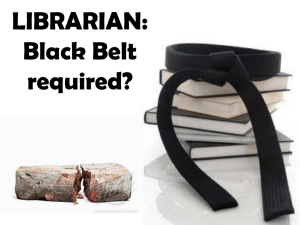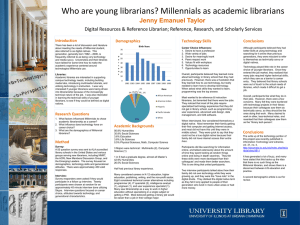SERVICE TO YOUNG PATRONS
advertisement
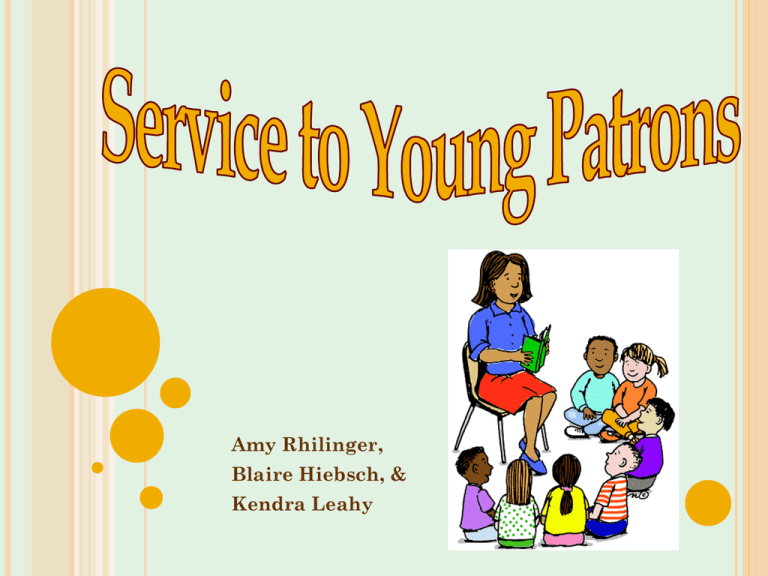
Amy Rhilinger, Blaire Hiebsch, & Kendra Leahy INTRODUCTION TO REFERENCE SERVICES TO CHILDREN Variety within this group Birth to Pre-school School age Young Adult Many similarities to adult patrons Reference Interview Collection Development WHAT MAKES CHILDREN SPECIAL? Developmental stages More imposed queries Information searching requires more guidance Vocabulary Limited Specialized Experimental MAKING FRIENDS WITH CHILDREN’S REFERENCE The child is the patron, they are the priority Adult, other third party, should be used as support Talk with respect, often mirroring their style Familiarize yourself with their influences Nick Jr., Cartoon Network, latest gaming systems PRE AND EARLY LITERACY BEGIN AT THE BEGINNING Anticipate information needs for children with ready reference & book lists sleep, eating, potty training, new siblings Picture book award winners, books of the year lists, seasonal themes Non-fiction collections include every day topics made simple money, time, weather also favorites like dinosaurs, construction, animals and princesses Include non-printed material videos and music are important ways to teach academic concepts PROGRAMMING AS REFERENCE SERVICE “Early language enrichment such as adults talking, signing or reading to children can advance the development of children from all backgrounds to realize biological potentials well beyond norms” (Rakes) Can be used to promote collections Familiarizes patrons with library and librarians Partnering with local agencies introduces additional resources STARTING YOUNG: KINDERGARTEN Children between the ages five and six years of age Starting to Read Books that stimulate thinking Catches and holds student’s attention Suspense is classic Sounds of rhythms Books can be Fiction or Nonfiction Pictures need to be accurate Early success helps them to gain their momentum for learning. AGE GROWING UP WITH BOOKS: ELEMENTARY AGE Comes with Age Categorize Differences Important for Librarians Development of collection Key to success Readers Advisory-Essential Determine children’s interest/ needs Grade/ Reading level HELPING STUDENTS : SCHOOL, HOMEWORK &COMPUTERS Information seeking Education Natural teachers Children rely on library for Information needs Helping with curriculum Local or State requirements System of Communication Home work support Electronic Impact Internet can be extremely problematic for a child Librarians are important advisors “Jumping Off” sites TAKING THE INITIATIVE: LIBRARIES ACROSS THE COUNTRY Maryland Baltimore County Public Library and Harford County Public Library creating AskUSNow! Increased participation Virginia Augusta County’s schools and public libraries working together for summer reading programs. Increased circulation Colorado Denver’s Public Library development of “A Community of Learners” Increased student population LIBRARY & REFERENCE SERVICES TO YOUNG ADULTS Young Adult: Ages 12-18 “Teens are substantial users of public libraries and the primary users of secondary school libraries. Their presence and numbers, as well as their developmental characteristics and life circumstances present a distinct challenge for reference service providers.” (YALSA, 2006) CHALLENGES OF PROVIDING REFERENCE SERVICES TO YOUNG ADULTS Teens are less likely to ask a librarian if they need assistance Often looking for homework help - Imposed queries Their queries are sometimes very vague or very broad Teens are very tech savvy, will often seek help through virtual reference Librarians often have certain prejudices against teens or are uncomfortable working with them READERS ADVISORY TO TEENS Historically, reading was viewed as potentially harmful to teens More progressive librarians would suggest using “lighter adult literature” as a way to lead young adults to more developed literature Many varying opinions on librarians role in “censoring” what a young reader may check out Parents play an active role – Reader’s Advisory by proxy Booktalking: “A formal or informal presentation about a book or group of books designed to entice the listener into reading them” (Chelton, 1976) Reader’s Advisory databases for Young Adults NoveList What do Young Adults Read Next? (www.gale.net) ENGAGING YOUNG ADULTS Create space within library Teen advisory boards Offer activities beyond internet service and books Incorporate technology into programming BIBLIOGRAPHY: FOR INTRO AND PRESCHOOLERS (2001). Competencies for librarians serving children in public libraries. Journal of Youth Services in Libraries, 14(2), 21-4. Retrieved from Library Lit & Inf Full Text database Brown, A. (2004). Reference services for children: information needs and wants in the public library. Australian Library Journal, 53(3), 261-74. Retrieved from Library Lit & Inf Full Text database Danley, E. (2003). The Public Children's Librarian As Educator. Public Libraries, 42(2), 98-101. Retrieved from Library Lit & Inf Full Text database Gross, M. (2000). The imposed query and information services for children. Journal of Youth Services in Libraries, 13(2), 10-17. Retrieved from Library Lit & Inf Full Text database Pattee, A. (2008). What Do You Know? Applying the K-W-L Method to the Reference Transaction with Children. Children & Libraries, 6(1), 30-1, 34-9. Retrieved from Library Lit & Inf Full Text database Rakes, J. (2010). The Power of Partnerships: Opening Children's Minds through Collaborative Early-Learning Programs. Florida Libraries, 53(2), 8-10. Retrieved from Library Lit & Inf Full Text database BIBLIOGRAPHY: FOR ELEMENTARY CHILDREN Bopp, R. (2001) Reference and information services: an introduction. Library and information science text series. Englewood, Colo. : Libraries Unlimited. Brazell, B. (1999). The Library Laboratory: An Experiment in Library Instruction with Students at the Denver Public Library. Colorado Libraries, 25 (1) 22-24. Bundy, A. (2006). Supporting Students: The Educational Contribution of Australia’s Public Libraries. Australasian Public Libraries and Information Services, 19, 126-136. Coulter, T. (2010). Another Opinion: The Public Library and the Public School Join Forces. Library Media Connection, August/September, 42. Drummond, M. (2003). Bridging the School and Public Library Divide: Victorian Teacher Release to Industry Program. Australasian Public Libraries and Information Services, 16(2) , 72-75. Francher, P., Francher G. (1962). The Creative Elementary School Library and the Public Library. Wilson Library Bulletin 36, 555-557. Minnick, M. (2001). An Investigation of Library Services Offered to Kindergarten Students in Rural Public Schools in Washington County, Pennsylvania. Rural Libraries, 21 (2), 37-54. Thompson, J. (2003). After School and Online. The Youthpage: Considering the Needs of Younger Patrons. Winter, 35-37. Van Der Walt. P.R., Cloete L.M., and Jacobs L. (2007). The Design of an Information Literacy Instruction Programme for Upper Elementary Children in The Public Library. Mousasion, 25 (1). 82-98 BIBLIOGRAPHY: FOR YOUNG ADULTS Bannwart, S. (2007). Reference and information services for the next generation. Indiana Libraries, 26(1), 46-48. Bunge, C. A. (1994). Responsive reference service. School Library Journal, 40(3), 142. Booth, H. (2006). Reader's advisory by proxy: Connecting teens and books through positive interactions with parents and caregivers. Young Adult Library Services, 5(1), 14-15. Bunge, C. A. (1994). Responsive reference service. School Library Journal, 40(3), 142. Cassell, K. A., & Hiremath, U. (2009). Reference and information services in the 21st century : An introduction (2nd ed.). New York: Neal-Schuman Publishers. Chelton, M. K. (1976). Booktalking. School Library Journal, 22(8), 39. Farrelly, M. G. (2007). Bother the librarians! Public Libraries, 46(1), 36-38. Hill, N. M. (2008). Teens--perpetual problem, or golden opportunity? Public Libraries, 47(1), 24-32. Pierce, J. B. (2006). The borderland age and borderline books: The early practice of reader's advisory for youth. Young Adult Library Services, 5(1), 4247. Walter, V. A., & Mediavilla, C. (2005). Teens are from neptune, librarians are from pluto: An analysis of online reference transactions. Library Trends, 54(2), 209-227. Young Adult Library Services Association. (2008). Guidelines for library services to teens, ages 12-18. Retrieved from www.ala.org

